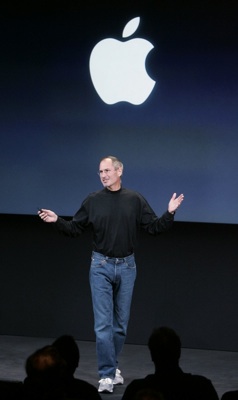 Today’s top stories involve Apple. One says Steve Jobs will not deliver the keynote at MacWorld, leaving the job to chief lieutenant Phil Schiller. And this will be the last MacWorld for Apple to boot. The other story involves reports that Apple will release two netbooks at the same show.
Today’s top stories involve Apple. One says Steve Jobs will not deliver the keynote at MacWorld, leaving the job to chief lieutenant Phil Schiller. And this will be the last MacWorld for Apple to boot. The other story involves reports that Apple will release two netbooks at the same show.
Separating facts from speculation is always difficult with Apple. The company’s commitment to closely held product plans is central to its DNA, though recent announcements have been surprisingly and quite accurately foreshadowed by rumor sites. But the big stories – the iPhone, the move to Intel processors, even the reboot of the hardware signaled by the MacBook Air – have been tours de force in marketing and breaking out ahead of the pack.
In these tenuous times of economic crisis, Silicon Valley looks to Apple for signs of rescue from the downward spiral. MacWorld has always been a counterpoint to CES and the Bill Gates keynote, and in recent years has handily trumped the Vegas expo in the news. But Apple has shifted its product roadmap in recent times to iterative consolidation of its more epic leaps, with refreshes of the notebook lines around the Air hardware development process, the transition to iPhone 3G, the App Store, and Mobile Me.
Steve Jobs has used these mini-events to consolidate Apple’s control of the marketing process away from third party events, and downsized his personal involvement in favor of a team approach at the recent WorldWide Developers Conference. Certainly concern about the CEO’s health plays some role in these shifts, but more important is maintaining a strategic momentum in staying out front of the sweet spot of the two markets Apple is leading.
It seems unlikely Apple would undercut Air sales with a netbook strategy, and equally dubious that Phil Schiller would be given that task. There’s room in the refresh cycle to either abandon the Mini or consolidate it in a portable context, but that would play more into Google’s hands as yet one more device to offer Google Apps and Chrome. One thing Jobs has never done is to blur the distinction between his products and the rest of the market.
As for the iPhone, the news is good and getting better. It’s hard to ignore the number of people who are leaving hardware at home and venturing to meetings with just the iPhone as their net connection. Though some see the G1 as challenging the iPhone with Flash support and relaxed application controls, Apple has much less to concede to slow competitive pressure. Already services such as Qik are transcoding user videos into Quicktime format, and eventually pressure will encourage Apple to allow applications such as the Qik recorder for the iPhone to be made available to the public.
Stepping back from the day-to-day turmoil and looking at where we are a year and a half after the iPhone’s release, Google’s on-demand cloud apps have fundamentally transformed how we reach the Web. Not only has the free suite of mail, calendar, chat, video conferencing, and collaboration tools finally pushed Microsoft into the game, but the shift of our data to the cloud has made the interchange between phone and computer seamless.
Apple understands how we work in this new paradigm, and has provided the necessary tools for managing the work of information triage in this burgeoning world of realtime virtualization. The device matters more than ever, but not as an island unto itself. Deficiencies on the iPhone such as lack of copy and paste can be managed through services that provide addresses, phone numbers, and microbites of information as part of reminders or task lists. Gmail’s new task list keyboard shortcut for email items can be extended to harvest other links, and pushed to the iPhone for action on the go.
Virtualizing information flow creates a strategic barrier to those who follow, and Apple is out ahead in each major area except the ones that Google must own to continue to grow. Understanding the Google imperative frees Apple to take advantage of the Google “middleware” layer to stitch its hardware together across the various nodes of our work and play life. This virtual life style is more efficient for companies seeking to outsource their workforces while maintaining the subtle group dynamics that lead to success in difficult times.
Killing off the MacWorld conference is just such a pragmatic business decision at the enterprise level; there’s no need for a conference to evangelize the next wave of products when the current wave already does the trick. Apple’s challenge is to pry open the carriers to transport the video endpoints from mobile devices, and work with Google and others to create software to take advantage of multiple collaborative endpoints that know where you are and behave accordingly. This orchestration of business processes around streaming video, micromessaging, and social identity is the IP that Apple lives on and for.